Book contents
- Frontmatter
- Contents
- Introduction: War and Reform in Spain and Its Atlantic Empire
- I Alberoni, Patiño, and the Beginnings of Atlantic Reform, 1713–1736
- II The Second Wave of Reform, 1736–1763
- 4 War and Reform, 1736–1749
- 5 Clerical Reform and the Secularization of the Doctrinas de Indios
- 6 The Downfall of Ensenada and the Pause, 1750–1763
- III Pinnacle of the Bourbon Reforms, 1763–1796
- Timeline for the Spanish Atlantic World in the Eighteenth Century
- Bibliography
- Index
- Plate section
- References
5 - Clerical Reform and the Secularization of the Doctrinas de Indios
Published online by Cambridge University Press: 05 June 2014
- Frontmatter
- Contents
- Introduction: War and Reform in Spain and Its Atlantic Empire
- I Alberoni, Patiño, and the Beginnings of Atlantic Reform, 1713–1736
- II The Second Wave of Reform, 1736–1763
- 4 War and Reform, 1736–1749
- 5 Clerical Reform and the Secularization of the Doctrinas de Indios
- 6 The Downfall of Ensenada and the Pause, 1750–1763
- III Pinnacle of the Bourbon Reforms, 1763–1796
- Timeline for the Spanish Atlantic World in the Eighteenth Century
- Bibliography
- Index
- Plate section
- References
Summary
Following the War of Jenkins’ Ear in 1748, the new Bourbon monarch, Ferdinand VI (1746–1759) presided over a full-fledged reforming impulse to strengthen the state apparatus, to build a stronger military (particularly the navy), to control political and commercial ties with the empire, and to curb the power of Rome over the Spanish church. While earlier Bourbon efforts to reform the imperial system focused largely on the transatlantic trade, these new initiatives would involve a fundamental reexamination of the role of important interest groups within the empire, including the traditionally close relationship between church and state in the Spanish Atlantic world. The power of the more independent religious orders – such as the Franciscans, Augustinians, Dominicans, Mercedarians, and Jesuits – came under particularly close scrutiny. Indeed, clerical reforms begun by King Ferdinand’s regalist ministers set the agenda for relations between church and state, which his successor, Charles III (1759–1788), later advanced with the expulsion of the Jesuits in 1767. These Bourbon reforms of the church merged Enlightenment ideas from Europe with a variety of discourses of reform from the Indies about local political, social, and economic ills. Regalist policy makers in Madrid drew on all this information to fashion pragmatic imperial reforms using the most up-to-date ideas available to them. At the same time, Bourbon clerical reforms emerged in a highly contested political arena with many competing ideological agendas, which shaped its contours over the course of the eighteenth century.
- Type
- Chapter
- Information
- The Spanish Atlantic World in the Eighteenth CenturyWar and the Bourbon Reforms, 1713–1796, pp. 167 - 193Publisher: Cambridge University PressPrint publication year: 2014

